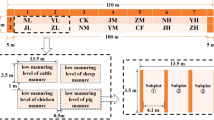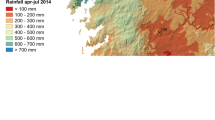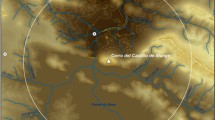Abstract
The nitrogen isotope compositions of charred wheat and barley grains reflect manuring intensity and have been used to reconstruct past manuring practices at archaeological sites across Europe and western Asia. To assess whether this analytical method can be applied to a staple crop in the West African Sahel, the nitrogen isotope values of Pennisetum glaucum grains in this region were determined and the effect of charring ascertained. Pennisetum glaucum ears were collected from fields in northeast Senegal, where the fertilisation histories of the plots (manure and/or household waste) were known. The nitrogen isotope values of these millet grains provide an insight into the values to expect for P. glaucum grains grown with low to moderate addition of manure/household waste in a semi-arid climate. Charring of P. glaucum grains by heating at 215–260 °C for 4–24 h increases their nitrogen isotope values by a maximum of 0.34‰. In light of these modern data, the nitrogen isotope values of millet grains recovered from the archaeological settlement mound of Tongo Maaré Diabal, Mali, can be interpreted as evidence for modest levels of manure/household waste input throughout the occupation of the site from cal ad 500–1150. This study demonstrates the potential for nitrogen isotope values of P. glaucum grains to shed light on past farming practices in West Africa.











Similar content being viewed by others
References
Adams R (1981) Heartland of cities: surveys of ancient settlement and land use on the central floodplain at the Euphrates. University of Chicago Press, Chicago
Algaze G (2001) Initial social complexity in southwestern Asia: the Mesopotamian advantage. Curr Anthropol 42:199–233. https://doi.org/10.1086/320005
Blench R (2014) African agricultural tools. Implications of synchronic ethnography for agrarian history. In: Stevens CJ, Nixon S, Murray MA, Fuller DQ (eds) Archaeology of African plant use. Oxbow Books, Oxford, pp 243–257
Bogaard A, Heaton THE, Poulton P, Merbach I (2007) The impact of manuring on nitrogen isotope ratios in cereals: archaeological implications for reconstruction of diet and crop management practices. J Archaeol Sci 34:335–343. https://doi.org/10.1016/j.jas.2006.04.009
Bogaard A, Fraser R, Heaton THE et al (2013) Crop manuring and intensive land management by Europe’s first farmers. PNAS 110:12,589–12,594. https://doi.org/10.1073/pnas.1305918110
Bogaard A, Hodgson J, Nitsch E et al (2016) Combining functional weed ecology and crop stable isotope ratios to identify cultivation intensity: a comparison of cereal production regimes in Haute Provence, France and Asturias, Spain. Veget Hist Archaeobot 25:57–73. https://doi.org/10.1007/s00334-015-0524-0
Bogaard A, Styring A, Whitlam J, Fochesato M, Bowles S (2018a) Farming, inequality, and urbanization: a comparative analysis of late prehistoric Northern Mesopotamia and southwestern Germany. In: Kohler TA, Smith ME (eds) Ten thousand years of inequality, the archaeology of wealth differences. University of Arizona Press, Tucson, pp 201–229
Bogaard A, Styring A, Ater M et al (2018b) From traditional farming in Morocco to early urban agroecology in northern Mesopotamia: combining present-day arable weed surveys and crop ‘isoscapes’ to reconstruct past agrosystems in (semi-)arid regions. Environ Archaeol 23:303–322
Boserup E (1965) The conditions of agricultural growth. Aldine Publishing Company, New York
Champion L, Fuller DQ (2018) New evidence on the development of millet and rice economies in the Niger river basin: archaeobotanical results from Benin. In: Mercuri A, D’Andrea A, Fornaciari R, Höhn A (eds) Plants and people in the African past. Springer, Cham, pp 529–547
Charles M, Forster E, Wallace M, Jones G (2015) “Nor ever lightning char thy grain”: establishing archaeologically relevant charring conditions and their effect on glume wheat grain morphology. STAR 1:1–6. https://doi.org/10.1179/2054892315Y.0000000008
Craine JM, Elmore AJ, Aidar MPM et al (2009) Global patterns of foliar nitrogen isotopes and their relationships with climate, mycorrhizal fungi, foliar nutrient concentrations, and nitrogen availability. New Phytol 183:980–992. https://doi.org/10.1111/j.1469-8137.2009.02917.x
DeNiro MJ, Hastorf CA (1985) Alteration of 15N/14N and 13C/12C ratios of plant matter during the initial stages of diagenesis: Studies utilizing archaeological specimens from Peru. Geochim Cosmochim Acta 49:97–115. https://doi.org/10.1016/0016-7037(85)90194-2
DIN 19684 (1977) Methods of soil investigations for agricultural engineering. Beuth, Berlin
Ellis EC, Kaplan JO, Fuller DQ, Varvus S, Klein Goldewijk K, Veerburg PH (2013) Used planet: a global history. Proc Natl Acad Sci USA 110:7978–7985. https://doi.org/10.1073/pnas.1217241110
Fick SE, Hijmans RJ (2017) WorldClim 2: new 1-km spatial resolution climate surfaces for global land areas. Int J Climatol 37:4302–4315. https://doi.org/10.1002/joc.5086
Fraser RA, Bogaard A, Heaton THE et al (2011) Manuring and stable nitrogen isotope ratios in cereals and pulses: towards a new archaeobotanical approach to the inference of land use and dietary practices. J Archaeol Sci 38:2790–2804
Fraser RA, Bogaard A, Charles M et al (2013) Assessing natural variation and the effects of charring, burial and pre-treatment on the stable carbon and nitrogen isotope values of archaeobotanical cereals and pulses. J Archaeol Sci 40:4:754–754,766. https://doi.org/10.1016/j.jas.2013.01.032
Gestrich N (2013) The archaeology of social organisation at Tongo Maaré Diabal. Doctoral dissertation, University College London
Gestrich N, MacDonald KC (2018) On the margins of Ghana and Kawkaw: four seasons of excavation at Tongo Maaré Diabal (ad 500–1150), Mali. J Afr Archaeol 16:1–30
Gron KJ, Gröcke DR, Larsson M, Sørensen L, Larsson L, Rowley-Conwy P, Church MJ (2017) Nitrogen isotope evidence for manuring of early Neolithic Funnel Beaker Culture cereals from Stensborg, Sweden. J Archaeol Sci: Reports 14:575–579. https://doi.org/10.1016/j.jasrep.2017.06.042
Gurven M, Borgerhoff Mulder M, Hooper PL et al (2010) Domestication alone does not lead to inequality: intergenerational wealth transmission among horticulturalists. Curr Anthropol 51:49–64. https://doi.org/10.1086/648587
Halstead P (1989) The economy has a normal surplus: economic stability and social change among early farming communities of Thessaly, Greece. In: Halstead P, O’Shea J (eds) Bad year economics: cultural responses to risk and uncertainty, new directions in archaeology. Cambridge University Press, Cambridge, pp 68–80
Höhn A, Neumann K (2012) Shifting cultivation and the development of a cultural landscape during the Iron Age (0–1500 ad) in the northern Sahel of Burkina Faso, West Africa: Insights from archaeological charcoal. Quat Int 249:72–83. https://doi.org/10.1016/j.quaint.2011.04.012
Jones G, Wardle K, Halstead P, Wardle D (1986) Crop storage at Assiros. Sci Am 254:96–103
Kanstrup M, Thomsen IK, Andersen AJ, Bogaard A, Christensen BT (2011) Abundance of 13C and 15N in emmer, spelt and naked barley grown on differently manured soils: towards a method for identifying past manuring practice. Rapid Commun Mass Spectrom 25:2879–2887. https://doi.org/10.1002/rcm.5176
Lespez L, Le Drezen Y, Garnier A et al (2011) High-resolution fluvial records of Holocene environmental changes in the Sahel: the Yamé River at Ounjougou (Mali, West Africa). Quat Sci Rev 30:737–756. https://doi.org/10.1016/j.quascirev.2010.12.021
Lightfoot E, Przelomska N, Craven M, O′Connell TC, He L, Hunt HV, Jones MK (2016) Intraspecific carbon and nitrogen isotopic variability in foxtail millet (Setaria italica). Rapid Commun Mass Spectrom 30:487. https://doi.org/10.1002/rcm.7583
MacDonald KC, Champion L, Manning K (2017) Windé Koroji Ouest (Mali, second and third millennia BCE): the environmental and subsistence evidence. In: Rupp N, Beck C, Franke G, Wendt K (eds) Winds of change: archaeological contributions in honour of Peter Breunig. Habelt, Bonn, pp 165–180
Marshall F, Hildebrand E (2002) Cattle before crops: the beginnings of food production in Africa. J World Prehist 16:99–143. https://doi.org/10.1023/A:1019954903395
McClintock NC, Diop AM (2005) Soil fertility management and compost use in Senegal’s peanut basin. Int J Agr Sustain 3:79–91. https://doi.org/10.1080/14735903.2005.9684746
Nachtergaele FO, van Velthuizen HT, Verelst L (2009) Harmonized world soil database. http://pure.iiasa.ac.at/id/eprint/8958. Accessed 31 Aug 2018
Nitsch EK, Charles M, Bogaard A (2015) Calculating a statistically robust δ13C and δ15N offset for charred cereal and pulse seeds. STAR 1:1–8. https://doi.org/10.1179/2054892315Y.0000000001
Nitsch E, Andreou S, Creuzieux A et al (2017) A bottom-up view of food surplus: using stable carbon and nitrogen isotope analysis to investigate agricultural strategies and diet at Bronze Age Archontiko and Thessaloniki Toumba, northern Greece. World Archaeol 49:105–137. https://doi.org/10.1080/00438243.2016.1271745
Pelissier P (1966) Les paysans du Senegal. Imprimerie Fabregue, Saint-Yrieux
Prudencio CY (1993) Ring management of soils and crops in the west African semi-arid tropics: The case of the mossi farming system in Burkina Faso. Agric Ecosyst Environ 47:237–264. https://doi.org/10.1016/0167-8809(93)90125-9
Styring AK, Manning H, Fraser RA et al (2013) The effect of charring and burial on the biochemical composition of cereal grains: investigating the integrity of archaeological plant material. J Archaeol Sci 40:4767–4779. https://doi.org/10.1016/j.jas.2013.03.024
Styring AK, Ater M, Hmimsa Y et al (2016) Disentangling the effect of farming practice from aridity on crop stable isotope values: a present-day model from Morocco and its application to early farming sites in the eastern Mediterranean. Anthropocene Rev 3:2–22. https://doi.org/10.1177/2053019616630762
Styring AK, Charles M, Fantone F et al (2017a) Isotope evidence for agricultural extensification reveals how the world’s first cities were fed. Nat Plants 3:17076. https://doi.org/10.1038/nplants.2017.76
Styring AK, Rösch M, Stephan E, Stika H-P, Fischer E, Sillmann M, Bogaard A (2017b) Centralisation and long-term change in farming regimes: comparing agricultural practices in Neolithic and Iron Age south-west Germany. Proc Prehist Soc 83:357–381
Szpak P, Metcalfe JZ, Macdonald RA (2017) Best practices for calibrating and reporting stable isotope measurements in archaeology. J Archaeol Sci: Rep 13:609–616. https://doi.org/10.1016/j.jasrep.2017.05.007
Vaiglova P, Bogaard A, Collins M et al (2014a) An integrated stable isotope study of plants and animals from Kouphovouno, southern Greece: a new look at Neolithic farming. J Archaeol Sci 42:201–215. https://doi.org/10.1016/j.jas.2013.10.023
Vaiglova P, Snoeck C, Nitsch E, Bogaard A, Lee-Thorp J (2014b) Impact of contamination and pre-treatment on stable carbon and nitrogen isotopic composition of charred plant remains. Rapid Commun Mass Spectrom 28:510. https://doi.org/10.1002/rcm.7044
Vignola C, Masi A, Balossi Restelli F et al (2017) δ13C and δ15N from 14C-AMS dated cereal grains reveal agricultural practices during 4300 – 2000 bc at Arslantepe (Turkey). Rev Palaeobot Palynol 247:164–174. https://doi.org/10.1016/j.revpalbo.2017.09.001
Walicka Zeh RA, MacDonald KC (2004) An ethnoarchaeological study of architectural remains and spatial organisation, an example from the site of Tongo Maaré Diabal, Mali. In: Sanogo K, Togola T (eds) Proceedings of the 11th Congress of the PanAfrican Association for Prehistory and Related Fields. Institut des Sciences Humaines, Bamako, pp 253–264
Acknowledgements
Our sincere thanks go to the farmers in Senegal, in particular Assane Lô and Sherif Loum, for permission to access their fields and for providing cultivation histories. We also thank the USDA project ‘Projet Services Entreprises Mil Sénégal’ for access to their database and for their help during the sampling of P. glaucum in Senegal. We would like to thank Doris Bergman-Dörr and Dagmar Schneider at the Institut für Physische Geographie, Goethe Universität Frankfurt am Main, for their assistance in soil analyses. We are also grateful to Jens Fiebig and Sven Hofmann for their assistance in isotopic determinations at the Institut für Geowissenschaften, Goethe Universität Frankfurt am Main, Germany, and to Peter Ditchfield for his assistance at the Research Laboratory for Archaeology and the History of Art, University of Oxford, UK. AS is funded by the Alexander von Humboldt Foundation. The excavations at TMD were funded by the Prehistoric Society, the British Academy and the Arts and Humanities Research Council, UK (KCM 1993–1996) and by the Royal Anthropological Institute’s Emslie Horniman Scholarship, the UCL Institute of Archaeology and the Tweedie Exploration Fellowship (NG 2010). We would also like to thank Jessica Metcalfe and an other anonymous reviewer for their insightful comments, which have greatly improved the manuscript.
Author information
Authors and Affiliations
Corresponding author
Additional information
Communicated by F. Bittmann.
Publisher’s Note
Springer Nature remains neutral with regard to jurisdictional claims in published maps and institutional affiliations.
Electronic supplementary material
Below is the link to the electronic supplementary material.
Rights and permissions
About this article
Cite this article
Styring, A.K., Diop, A.M., Bogaard, A. et al. Nitrogen isotope values of Pennisetum glaucum (pearl millet) grains: towards a reconstruction of past cultivation conditions in the Sahel, West Africa. Veget Hist Archaeobot 28, 663–678 (2019). https://doi.org/10.1007/s00334-019-00722-9
Received:
Accepted:
Published:
Issue Date:
DOI: https://doi.org/10.1007/s00334-019-00722-9




